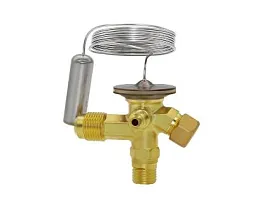The management of the main function of a refrigeration circuit is entrusted to a small and simple valve, the expansion valve. The excellent optimization of this component increases the efficiency of the entire system.
Essentially, the synergy of this valve with all the components characterizes the refrigeration circuit and makes it possible to maintain constant performance through all climatic variations throughout the year.
The valve series 2028E is a throttling device that receives liquid from the condenser and injects it into the evaporator, creating the necessary pressure drop across the expansion orifice. It regulates the refrigerant flow into the evaporator by modulating the opening time phase of the Plunger, allowing for a wide power range. It is an ON/OFF valve that must be regulated with the Pulse Width Modulation (PWM) principle.
It is driven by an electronic regulator, and in that way it allows a more accurate metering of the refrigerant reaching a greater efficiency (and then a sensible decrease of the plant management costs) and a faster response to the variations of the evaporator load.
The valve can guarantee an hermetic sealing when it is in the closed position, and work as a normally close solenoid valve.
This means that you can install this valve in the system as the only valve in the liquid line before expansion, you can remove the solenoid valve before the lamination.
The valve can be actuated with any voltage supply. A wide range of coils are listed in the Castel handbook, with al lot of connections and electrical characteristics, properly studied to fit any customer need.
The valve can work with all R744 fluid conditions, subcritical or transcritical state; the integrity of the body, and the lifetime durability of the stainless steel, guarantee a very high number of switching cycles.
Simplicity and safety are the major qualities that distinguish this expansion valve, capable of operating up to 90 bar, as well as being able to operate even with pressure differential values above 40 bar.
